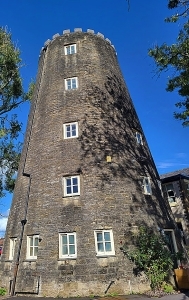A mill and a bottle in a village in Lancashire
PARBOLD IS A village about 16 miles northeast of the centre of Liverpool. In 1742, the Douglas Navigation, a canal that links Wigan and Liverpool, became operational. It carried stone, coal, and other goods to Liverpool from where they could be shipped to Dublin. The canal passes through the centre of Parbold, and led to the mining of coal in the area. In turn, this led to an increase in the village’s population. With the arrival of the railway in 1855, Parbold became more easily accessible to Manchester and Wigan. This resulted in wealthy inhabitants of these towns coming to live in Parbold. And in the 1960s and 1970s, new housing estates were built in the area. Despite this, Parbold remains a charming place to visit.
 Parbold mill
Parbold millParbold Hall, which was built in the 1750s, housed a Benedictine School. This institution was the forerunner of the leading Roman Catholic Ampleforth School, which opened in North Yorkshire in 1802. Soon after that, the boys studying at Parbold Hall were moved to Ampleforth, and the Parbold school was closed. Currently, the hall is privately owned, and let out for weddings and holiday accommodation.
One of Parbold’s main attractions is the tall, conical tower that was once a windmill. It stands next to the canal, and replaced a water mill that no longer exists. A website published by West Lancashire Borough Council related that the tall mill:
“… replaced the water cornmill which once stood near the Douglas bridge in Alder Lane. The windmill in its turn was superseded in the middle on the 18th century by the present mill which was originally worked by a steam engine and produced compound cattle foods until its closure in 1985.”
Part of the former mill is now an art gallery. Next to it, there is a pub appropriately named The Windmill. It opened in 1794 to serve both the growing traffic along the newly opened sections of the Leeds to Liverpool Canal and the farmers delivering grain to the neighbouring windmill. It soon became a meeting place for locals. Today, it incorporates a restaurant in addition to the usual bars.
The most interesting sight in Parbold is on a hill overlooking the village and the fields around it. Looking like the top third of a wine bottle, it is a stone monument known as both the Reform Pillar and the Parbold Bottle. It was erected by local worthies to replace another structure, which commemorated the passing of The Reform Act in 1832. The Act made great changes in the electoral system by changing constituency boundaries; creating new constituencies in areas that had been hitherto unrepresented in Parliament; and extending the franchise, giving the vote to all men owning houses over £10 in rateable value. It was the beginning of the path that led eventually to universal suffrage in Great Britain. As a result of the Act, Lancashire gained 11 new Members of Parliament. The bottle-shaped monument was badly damaged by a gale in 1942, but was restored in 1958. A short path leads from a busy main road to the Bottle from which lovely views can be obtained. The monument itself, although interesting, is not a thing of beauty.
Today, Parbold is mainly residential and a popular place for those wishing to walk along the canal or to go fishing. And apart from The Windmill pub, there are several other places where refreshment can be obtained.



